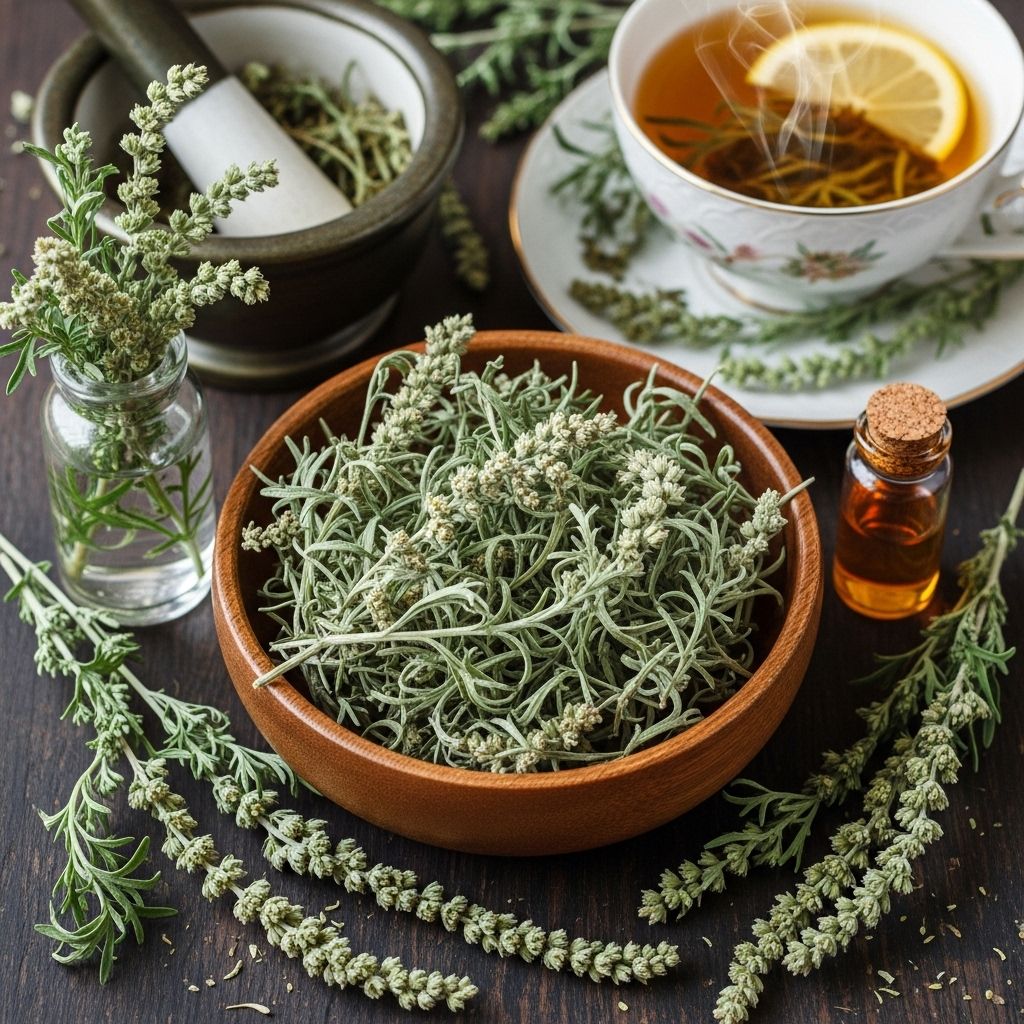Wormwood (Artemisia absinthium): Nature’s Bitter Herb – Benefits, Uses, and Flavor Profile Explained
Bold bitterness from this herb elevates cocktails, recipes, and herbal remedies.

Wormwood, scientifically known as Artemisia absinthium, is a herbaceous perennial plant renowned for its historical significance, potent medicinal properties, and distinctive flavor. Native to Eurasia and North Africa, wormwood has established a place in global herbal medicine, culinary traditions, and even the world of spirits. This comprehensive guide explores what wormwood is, details its health benefits, elucidates its traditional and modern uses, and describes its unique taste profile.
Table of Contents
- Introduction to Wormwood
- Botanical Overview and Varieties
- History and Cultural Significance
- Chemical Composition of Wormwood
- Health Benefits of Wormwood
- Traditional and Modern Uses of Wormwood
- Culinary Uses and Taste Profile
- Safety, Side Effects, and Precautions
- FAQs About Wormwood
Introduction to Wormwood
Wormwood is a perennial, aromatic herb that belongs to the daisy (Asteraceae) family, recognized for its lacy, grey-green leaves, pale yellow tubular flowers, and a sage-like aroma. It thrives in poor, dry soils under full sun and is commonly found in waste areas, overgrazed rangelands, along roadsides, and pastures. Wormwood has been naturalized across much of Europe and North America, introduced there for medicinal and horticultural purposes in the 19th century.
Botanical Overview and Varieties
- Scientific Name: Artemisia absinthium
- Family: Asteraceae (daisy family)
- Origin: Native to Eurasia and Northern Africa
- Physical Characteristics:
- Height: Typically 0.8–1.2 m (2 ft 7 in – 3 ft 11 in)
- Leaves: Spirally arranged, greenish-grey above, white below, covered in silvery-white tiny hairs
- Flowers: Tubular, pale yellow, clustered in drooping globular heads
- Roots: Taproot up to 5 cm diameter with branching lateral roots
- Scent: Sage-like when crushed
- Common Varieties:
- Common Wormwood: A. absinthium – the archetypal species used medicinally and in absinthe production
- Powis Castle Wormwood: (Artemisia ‘Powis Castle’) – a garden cultivar prized for its silvery foliage and fine texture
- Mugwort: (Artemisia vulgaris) – similar but distinguished by lighter flower color and greener foliage
History and Cultural Significance
Wormwood’s history extends over several millennia, permeating the realms of herbal medicine, folklore, and gastronomy:
- Ancient Medicine: Used in ancient Egypt, Greece, and Rome for treating digestive issues, parasites, and as a general restorative.
- The Absinthe Connection: In the 18th and 19th centuries, wormwood became famous as the key ingredient in absinthe, an anise-flavored spirit enjoyed by artists and intellectuals throughout Europe.
- Vermouth: The herb gives its name to “vermouth,” a fortified wine traditionally flavored with wormwood, originating from the German “Wermut”.
- Medicinal Folk Traditions: Mugwort, wormwood’s relative, was historically prescribed for gynecological complaints and named after Artemis, the Greek goddess of childbirth.
Wormwood in Lore and Literature
- Historically regarded as a powerful bitter herb with protective and purifying qualities.
- Cited in the Bible as a symbol of suffering and bitterness.
- Used as a natural pesticide and for treating intestinal worms—hence the name wormwood.
Chemical Composition of Wormwood
Wormwood’s potency arises from its unique chemical constituents, which contribute both to its health impacts and taste:
- Thujone: The most notable compound, found in high concentrations, responsible for its bitterness and historically associated (at high doses) with neurotoxicity.
- Other Essential Oils: Includes absinthin, anabsinthin, and artabsin, which contribute to flavor and medicinal properties.
- Flavonoids and Tannins: Antioxidants which confer anti-inflammatory and potential protective effects.
- Terpenoids: Contribute to aroma and therapeutic effects.
Modern regulations ensure that absinthe and other wormwood-containing products have restricted thujone levels to maintain safety in food and beverages.
Health Benefits of Wormwood
Wormwood’s traditional uses are supported—though not conclusively—by some modern research. Its prominent benefits include:
- Digestive Aid: Traditionally used to stimulate appetite and alleviate indigestion, bloating, and constipation. Its bitters encourage digestive juices and bile flow.
- Antiparasitic Properties: Used historically to expel intestinal worms, especially roundworms and pinworms.
- Anti-inflammatory and Antioxidant Effects: Wormwood’s flavonoids and terpenes exhibit anti-inflammatory activity, reducing discomfort in cases such as arthritis and autoimmune disorders.
- Antimicrobial and Antifungal Activity: Some studies suggest wormwood can inhibit bacteria and fungi growth, supporting traditional wound-care applications.
- Mood and Cognitive Support: Traditionally believed to have mild mood-enhancing and cognition supporting effects, though research is limited and further studies are needed.
- Potential Blood Sugar Regulation: Early research suggests possible roles in aiding metabolic health, but further clinical studies are required.
Table: Summary of Wormwood Health Benefits
| Benefit | Summary | Traditional Support | Modern Research |
|---|---|---|---|
| Digestive Aid | Stimulates appetite, improves digestion | Strong | Supported |
| Antiparasitic | Expels intestinal worms | Strong | Preliminary |
| Antimicrobial | Inhibits bacteria/fungi | Moderate | Some support |
| Anti-inflammatory | Reduces swelling/pain | Moderate | Some support |
Traditional and Modern Uses of Wormwood
Medicinal Uses
- Herbal Teas: Used for digestive discomfort and appetite stimulation.
- Tinctures and Extracts: Concentrated wormwood forms used to treat intestinal worms and support gall bladder function.
- Topical Preparations: Applied to bruises, cuts, and bites for disinfectant and anti-inflammatory effects.
- Component in herbal blends: Often found in traditional remedies for skin disorders, fever, and immune support.
Commercial and Garden Uses
- Absinthe Production: Wormwood is the defining ingredient in absinthe, lending both bitterness and supposed psychoactive effects. Modern absinthe contains regulated thujone levels to ensure safety.
- Vermouth and Other Spirits: Utilized for its distinctive bitter note and aromatic complexity in fortified wines and bitters.
- Garden Ornamental: Many wormwood varieties are grown for silvery foliage and aromatic qualities—Powis Castle wormwood (Artemisia ‘Powis Castle’) is a popular landscaping choice for drought-tolerant gardens.
Other Uses
- Pest Repellent: Planted in gardens or used indoors to deter insects due to its aromatic oils.
- Naturally derived pesticide: Used in organic gardening to control unwanted pests.
Culinary Uses and Taste Profile
The taste of wormwood is its most defining feature:
- Flavor: Highly bitter, herbaceous, and slightly medicinal, followed by a resinous aftertaste. The bitterness is primarily due to thujone and absinthin.
- Aroma: Sage-like and somewhat camphorous, which can overwhelm in excessive quantities.
Uses in Food and Drink
- Absinthe: The most famous beverage containing wormwood, celebrated for both its taste and its historical connection to fin-de-siècle artists.
- Vermouth: A key ingredient in classic cocktails like the Martini.
- Bitters: Added to herbal bitters and some liqueurs.
- Herbal Teas: Tiny amounts can underscore complexity in bitter herbal infusions—overuse is strongly discouraged.
- Culinary Use: Sparingly used to flavor fatty meats or stews in some traditional cuisines.
Table: Culinary Pairings for Wormwood
| Food/Drink | Role of Wormwood |
|---|---|
| Absinthe | Defining bitterness, herbal complexity |
| Vermouth | Bitter backbone, refreshing edge |
| Meat stews | Subtle bitterness, aroma |
| Bitters | Medicinal undertone |
Safety, Side Effects, and Precautions
For all its benefits, wormwood must be approached with caution. The plant’s high thujone content can be toxic if consumed in large amounts and may induce convulsions, renal failure, and other serious complications.
- Not recommended: For pregnant or breastfeeding women.
- May interact: With certain medications, especially anticonvulsants and those affecting liver enzymes.
- Potential side effects: Nausea, diarrhea, dizziness, and allergic reactions in susceptible individuals.
- Safe consumption: Limits set in commercial products greatly reduce risk; always follow dosage guidelines and consult a healthcare practitioner before medicinal use.
Note: Herbalists recommend starting with very low amounts in teas or tinctures and never ingesting pure oil.
Frequently Asked Questions (FAQs)
Q: What is the difference between wormwood and mugwort?
A: Wormwood (Artemisia absinthium) is more bitter and aromatic than mugwort (Artemisia vulgaris), which is traditionally used for gynecological complaints and has lighter flowers and greener leaves.
Q: Is wormwood safe to drink?
A: Commercially regulated wormwood extracts, teas, or spirits are considered safe when consumed in moderation. Excessive consumption or use of undiluted wormwood oil can be toxic.
Q: What does wormwood taste like?
A: Wormwood is intensely bitter, resinous, herbaceous, with a lingering medicinal and sage-like aftertaste.
Q: Can wormwood treat intestinal worms?
A: Traditional medicine has used wormwood as an antiparasitic, but modern evidence is preliminary. Consult a healthcare professional for diagnosis and treatment.
Q: What is absinthe and is it legal?
A: Absinthe is an anise-flavored alcoholic spirit historically containing wormwood. It is legal in many countries today, with regulated thujone content.
Q: Which foods and drinks commonly contain wormwood?
A: Absinthe, vermouth, bitters, and some herbal teas. It is rarely used directly in cooking, due to its potent bitterness.
Final Thoughts
Wormwood stands among nature’s most fascinating bitter herbs. Revered since antiquity, it bridges herbal medicine, culture, and even the world of fine spirits. Its health benefits are promising, though safety must always come first. Whether you’re drawn to its healing folklore, its distinctive flavor, or its impact on cocktail history, wormwood offers a sensory experience like no other plant.
References
- https://ssisc.ca/wormwood
- https://extension.okstate.edu/programs/plant-id/plant-profiles/wormwood/
- https://gobotany.nativeplanttrust.org/species/artemisia/vulgaris/
- https://en.wikipedia.org/wiki/Artemisia_absinthium
- https://www.missouribotanicalgarden.org/PlantFinder/PlantFinderDetails.aspx?kempercode=a938
- https://pmc.ncbi.nlm.nih.gov/articles/PMC7345338/
Read full bio of Sneha Tete












